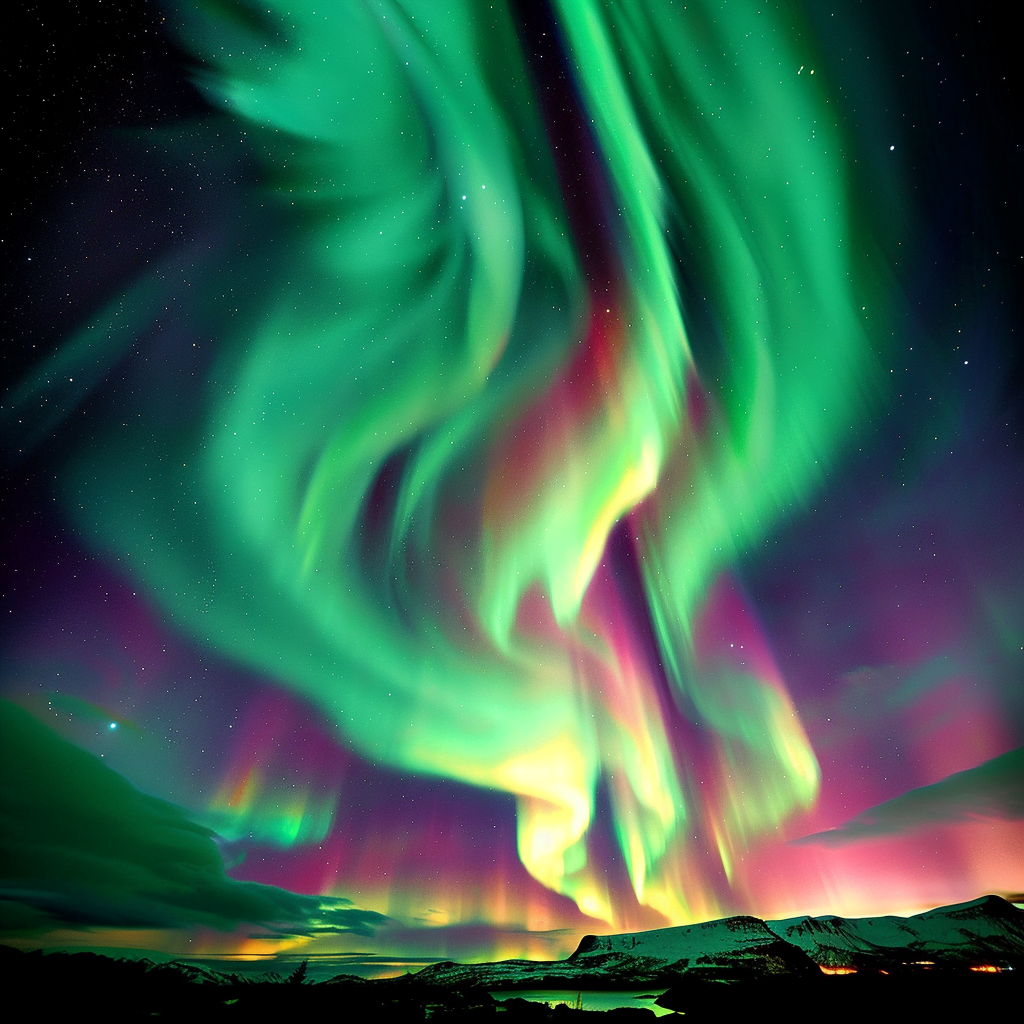Unravelling the Enigmatic Beauty of the Northern Lights – A Spectacular Display of Nature’s Majesty
In Iceland, I have often found myself entranced by the mesmerising dance of colours painting the night sky. The ethereal glow of the Aurora Borealis creates a breathtaking canvas above me, sparking a sense of wonder and curiosity.
What mystical forces are at play to orchestrate this celestial spectacle that graces the heavens with its elusive presence?
Join me on a captivating journey to explore the secrets and unravel the enigmatic beauty of the Northern Lights, a natural wonder that has captured the hearts and imaginations of people for centuries.
Key Takeaways
Experience the Enigmatic Beauty of the Northern Lights or Aurora Borealis
The breathtaking display of the northern lights or aurora borealis is a truly mesmerising spectacle. Whether you find yourself in the Arctic Circle or the southern reaches of Antarctica, the celestial dance of lights in the sky never fails to captivate and enchant those fortunate enough to witness it.
The scientific explanation behind this awe-inspiring natural phenomenon only serves to deepen its mystique, making it a must-see for anyone in search of an unforgettable encounter with nature. The enigmatic allure of the aurora borealis is a sight that leaves an indelible mark on all who have the privilege of witnessing it.
What are the Northern Lights?
The Northern Lights, also known as the Aurora Borealis, grace the night sky with their stunning array of colours. Solar winds and magnetic fields play a crucial role in shaping this mesmerising phenomenon.
The Earth’s magnetic field contributes to the creation of these celestial marvels, adding an extra layer of intrigue to their enchanting presence. Witnessing the dance of the Aurora Borealis is truly a captivating experience that showcases the beauty and complexity of nature’s wonders.
Understanding the Phenomenon of Aurora Borealis
The captivating phenomenon of Aurora Borealis, also known as the Northern Lights, illuminates the night sky with its vibrant colours and mesmerizing movements. This celestial beauty is a result of solar activity interacting with Earth’s magnetic field. Understanding the Aurora Borealis involves recognizing the interplay between various elements:
- Aurora colours: The colours in the Northern Lights depend on the gases present in the atmosphere, with oxygen producing green and red hues, and nitrogen contributing blues and purples.
- Solar activity: Fluctuations in the sun’s activity release charged particles into space, eventually reaching Earth and causing the spectacular displays of the Aurora Borealis.
- Atmospheric conditions: The clarity of the sky and the absence of light pollution greatly influence the visibility and intensity of the Northern Lights.
- Spectacular displays: The Aurora Borealis can manifest as gentle arcs or dynamic curtains, constantly shifting and painting the sky with its enchanting colours.
Factors Influencing the Appearance of the Northern Lights
The mesmerising dance of vibrant colours in the night sky, known as the Northern Lights or Aurora Borealis, is influenced by various factors. Solar activity, atmospheric conditions, and geographical location play crucial roles in determining the intensity and visibility of this celestial spectacle.
Regions closer to the magnetic poles have a higher likelihood of witnessing the Northern Lights due to the interaction between the Earth’s magnetic field and solar wind.
Light pollution can dim the auroras, making remote locations ideal for viewing this phenomenon. Spectacular spectral colours add to the celestial beauty of the Northern Lights, creating a magical display in the sky.
Significance of the Earth’s Magnetic Field in the Formation
The Earth’s magnetic field plays a crucial role in the formation of the natural light display known as the Northern Lights or Aurora Borealis.
Solar-induced magnetic anomalies can disrupt the Earth’s magnetosphere, setting the stage for the celestial dance of lights.
Geomagnetic storms enhance the colours of the auroras, painting the sky with vivid shades of green, pink, and purple.
The interaction between the solar wind and the Earth’s geomagnetic field triggers enchanting light shows that gracefully move across the polar regions.
Guided by the magnetic field, the intricate patterns of the auroras take shape, creating curtains, arcs, and coronas that enchant all observers of this breathtaking natural spectacle.
When and Where to See the Northern Lights

When and Where to See the Northern Lights
For those eager to witness the Aurora Borealis, understanding the optimal time of year, the prime locations globally for experiencing the enchanting lights, and the significance of utilising Aurora forecasts for planning your expedition are crucial factors to consider.
To maximize your chances of beholding this natural spectacle in all its splendor, adventurers should keep these key points in mind.
From Iceland to Norway, from Canada to Finland, the Northern Lights beckon those ready to embark on an extraordinary celestial journey.
Best Time of Year to Witness the Aurora Borealis
When planning to witness the enchanting Aurora Borealis, timing is key for a captivating experience. Here’s a guide on the best time of year to see the Northern Lights:
- Prime Locations: For optimal views, head to high-latitude areas near the Arctic Circle.
- Favourable Conditions: Clear, dark skies away from light pollution amplify the beauty of the Aurora Borealis.
- Peak Season: The ideal time to catch this celestial spectacle is during the winter months, from September to March.
- Mesmerising Moments: Prepare for unforgettable encounters under the dazzling Northern Lights display.
Make sure to choose the right time and place to witness nature’s breathtaking light show in all its glory.
Top Locations Worldwide for Viewing the Northern Lights
The Northern Lights: Top Locations Worldwide to Witness the Spectacle
When seeking out the best locations worldwide to witness the captivating spectacle of the Northern Lights, adventurers are drawn to remote corners of the globe where the celestial dance of colours paints the night sky with beauty.
Some ideal destinations for experiencing the Aurora Borealis include Tromsø in Norway, known for its prime locations offering uninterrupted views of the lights. Iceland, especially around Thingvellir National Park, is another perfect spot where the Northern Lights dance above the tectonic plates.
For those seeking the best views, Abisko National Park in Sweden is a top pick due to its clear skies and minimal light pollution. Canada’s Yukon Territory, particularly Whitehorse, also offers stunning displays, making it a top choice for witnessing this natural wonder.
Using Aurora Forecasts for Planning Your Trip
Let’s plan an unforgettable trip to witness the Northern Lights with the help of Aurora forecasts. Follow these steps for an optimal experience:
- Peak Seasons and Locations: Research the best times and locations to see the Northern Lights.
- Reliable Sources: Choose trustworthy sources like space weather prediction centers for accurate forecasts.
- Weather Check: Ensure clear skies and minimal light pollution for better visibility.
- Solar Activity Monitoring: Keep track of solar activity levels to anticipate aurora intensity.
Science Behind the Aurora

The display of the aurora is a result of nature’s forces in action. When solar wind and charged particles from the sun collide with Earth’s atmosphere, they create a spectacular light show.
These charged particles interact with Earth’s magnetic field, producing the enchanting curtains of light known as the Northern Lights.
The intensity and frequency of auroras are influenced by solar flares and storms, adding an element of unpredictability to this captivating phenomenon.
Role of Solar Wind and Charged Particles in Aurora Creation
The creation of the mesmerising Aurora Borealis is intricately linked to the solar wind and charged particles from the Sun. These charged particles interact with Earth’s magnetic field, leading to the spectacular light show in the sky.
As the particles collide with gases in the atmosphere, they emit colourful light, producing the vibrant auroras we admire. Guided by Earth’s magnetic field towards the poles, where they’re most commonly seen, these charged particles create a stunning display of green, pink, purple, and red hues.
Witnessing this celestial dance is truly a breathtaking experience that highlights the dynamic interactions between the solar wind and our planet’s magnetic field.
The Magnetic Dance: Interactions in Earth’s Magnetic Field
Navigating through Earth’s magnetic field unveils the mesmerizing dance of forces that choreographs the captivating spectacle of the Aurora Borealis. Influenced by interactions with the solar wind, the dynamics of the magnetic field create a celestial light show renowned for its geomagnetic activity.
This polar sky phenomenon occurs as charged particles from the sun interact with Earth’s magnetic field, producing an awe-inspiring play of light in the upper atmosphere. The ever-changing interactions lead to the enchanting display of shimmering curtains of colorful light dancing across the night sky, painting a vivid picture of nature’s grandeur and mystery.
Impact of Solar Flares and Storms on Auroral Activity
Unleashing the Impact of Solar Flares and Storms on Auroral Activity
Solar flares, those powerful bursts of energy from the sun, play a significant role in influencing the mesmerizing auroral activity that graces our night skies. These phenomena unveil the intricate science behind the captivating displays we witness.
1. Solar Flares Enhancing Auroral Activity
Solar flares have the remarkable ability to intensify auroral activity, resulting in more vibrant and awe-inspiring light shows in the atmosphere.
2. Aurora Activity Dynamics
Fluctuations in auroral patterns are intricately connected to the occurrence of solar flares and storms, directly impacting the visibility and intensity of the Northern Lights.
3. Sunspot Cycles and Auroral Frequency
The correlation between sunspot cycles and the frequency of auroral activity offers valuable insights into the predictability of these celestial events, shedding light on the patterns we observe.
4. Geomagnetic Storms and Auroral Behavior
Variations in Earth’s magnetic field caused by solar activity can trigger geomagnetic storms, which in turn influence the appearance and behavior of the auroras, creating ever-changing displays in the night sky.
Understanding these intricate relationships is essential for accurate space weather forecasting and predicting the spectacular displays of auroras that captivate us.
Exploring Aurora Borealis in Different Hemispheres

Explore the Southern Lights for a Unique Aurora Borealis Experience
Travelers seeking the enchanting spectacle of the Aurora Borealis can expand their horizons by exploring the Southern Lights in the opposite hemisphere. Contrasting the Northern and Southern Lights phenomena offers a glimpse into the unique characteristics of the Southern Lights, also known as the Aurora Australis.
Witnessing the impact of geomagnetic storms on Aurora displays presents an adventurous opportunity to marvel at the interconnected beauty of our planet and its celestial surroundings.
Discover the ethereal dance of the Aurora Australis for a one-of-a-kind Aurora Borealis experience that showcases the wonders of the Southern Hemisphere.
Contrasting Northern and Southern Lights Phenomena
Awe-Inspiring Comparison of Northern and Southern Lights Phenomena
- Solar Origins: The Northern Lights result from solar particles colliding with Earth’s atmosphere near the North Pole, while the Southern Lights form when solar winds interact with the atmosphere near the South Pole.
- Celestial Marvels: Both the Northern and Southern Lights are mesmerizing celestial displays that have captivated cultures for centuries.
- Distinctive Displays: The Northern Lights showcase vibrant hues of green, pink, and purple, whereas the Southern Lights exhibit more red and orange tones, creating a unique visual contrast.
- Natural Wonder: These phenomena highlight the interaction between Earth’s magnetic field and solar winds, offering a breathtaking spectacle for fortunate observers to witness in the polar regions.
Unique Characteristics of the Southern Lights (Aurora Australis)
The Southern Lights, or Aurora Australis, present a stunning celestial display in the southern hemisphere. This luminous ballet of colours, including shades of green, pink, and purple, paints the night sky with a phenomenal show of nature’s beauty.
Unlike its northern counterpart, the Aurora Borealis, the Aurora Australis graces the skies of Antarctica, Australia, New Zealand, and South America. This polar phenomenon, driven by solar winds interacting with the Earth’s magnetic field, creates a dance of light that leaves spectators in awe of the wonders of the universe.
Effect of Geomagnetic Storms on Aurora Displays
The captivating Aurora Australis in the southern hemisphere showcases the impact of geomagnetic storms on aurora displays worldwide. Here’s how these natural phenomena interact to create the stunning celestial light show:
- Solar Activity: The sun’s activity releases charged particles towards Earth, influencing the intensity and frequency of auroras.
- Magnetic Disturbances: Solar winds cause magnetic disturbances that interact with Earth’s magnetic field, leading to fluctuations.
- Geomagnetic Variations: These variations determine the visibility and location of the auroras, resulting in diverse patterns in the sky.
- Atmospheric Reactions: When solar particles collide with gases like oxygen and nitrogen, they produce the glowing hues of the aurora.
This cosmic dance between the sun, Earth, and the atmosphere paints the night sky with ethereal beauty through the Aurora Borealis and Aurora Australis.
Frequently Asked Questions
Can the Northern Lights Be Seen During Any Season Other Than Winter?
Yes, the northern lights can be seen in summer, spring, and autumn, not just in winter. These colourful auroras grace the night sky with their enchanting displays, providing year-round beauty for observers to enjoy. Whether it’s the vibrant hues of summer, the blooming landscapes of spring, or the cozy atmosphere of autumn, the northern lights never fail to surprise and delight with their presence.
How Do the Northern Lights Affect Wildlife in the Regions Where They Can Be Seen?
The Northern Lights impact wildlife behaviour in regions where they can be seen. These lights cause shifts in migration patterns, adjustments in circadian rhythms, and evolution of adaptation strategies in ecosystems. Nature’s creatures synchronise with this celestial spectacle, embracing its mystique and harmonizing with the changing environment.
Are There Any Superstitions or Myths Surrounding the Northern Lights in Different Cultures?
Northern Lights Superstitions and Myths Across Cultures
The mesmerizing Northern Lights have inspired a plethora of cultural beliefs, folklore tales, and superstitions worldwide. These myths highlight the mystical connections and spiritual significance attributed to the auroras, depicting them as divine messages, battlegrounds of spirits, or omens of fortune.
In the realm of superstitions and myths, the Northern Lights are often seen as more than just a natural phenomenon. Various cultures have woven intricate tales around these dancing lights in the sky, imbuing them with symbolic meanings and mystical powers. From being harbingers of good luck to omens of impending doom, the Northern Lights have captured the imagination of people across different cultures throughout history.
In Nordic folklore, the auroras were believed to be the reflections of the armour and weapons of the Valkyries as they rode across the night sky, choosing fallen warriors to take to Valhalla. In indigenous cultures of North America, the Northern Lights were seen as the spirits of ancestors dancing in the sky, celebrating important events or warning of dangers ahead.
These cultural beliefs surrounding the Northern Lights serve as a reminder of the deep connection between nature and spirituality in different societies. The enigmatic beauty of the auroras continues to mystify and inspire awe, keeping alive the ancient traditions and superstitions associated with this celestial wonder.
Can the Northern Lights Be Seen From Space?
Can the Northern Lights Be Seen From Space?
Astronauts have marvelled at the breathtaking views of the northern lights from space. The unique perspective from beyond Earth’s atmosphere offers a disctinct vantage point to witness these celestial displays. The cosmic wonders of our planet’s auroras can be seen dancing across the atmosphere, showcasing the beauty of these galactic phenomena.
Are There Any Specific Precautions to Take When Viewing the Northern Lights in Remote Locations?
When embarking on a journey to remote locations to witness the beauty of the northern lights, it is crucial to prioritise safety measures. To optimize your viewing experience, steer clear of light pollution that may hinder visibility. Remember to bring along a camera to capture the awe-inspiring sights for lasting memories. Keep an eye on solar activity updates to increase your chances of witnessing optimal aurora displays. Above all, savour the magical experience responsibly while being mindful of your surroundings.
How Do Indigenous Arctic Populations Interpret and Interact with the Aurora Borealis?
The aurora borealis holds deep cultural significance for the indigenous communities of the arctic. Many believe the lights are spirits or ancestors communicating from the heavens. Through stories and rituals, these communities interpret the aurora as a natural link between the earthly and spiritual worlds, guiding their interactions with nature.
Are Killer Whales Spotted Near Areas Where the Aurora Borealis Can Be Seen?
Killer whales are often spotted in Arctic and Antarctic waters, which are also prime locations to witness the Northern and Southern Lights. These majestic creatures thrive in colder regions, where incredible phenomena like the aurora borealis occur. Observing a natural rivalry like **killer whale vs great white** in such settings is rare, but possible.
Conclusion
Witnessing the unforgettable beauty of the northern lights or aurora borealis is a truly awe-inspiring experience. Whether in the Arctic Circle or down south in Antarctica, the dancing lights in the sky never fail to captivate and mesmerize those fortunate enough to witness them.
The scientific explanation behind this natural phenomenon only adds to its mystique, making it a must-see for anyone seeking an unforgettable adventure in nature. The enigmatic allure of the aurora borealis is a spectacle that leaves a lasting impression on all who behold it.


